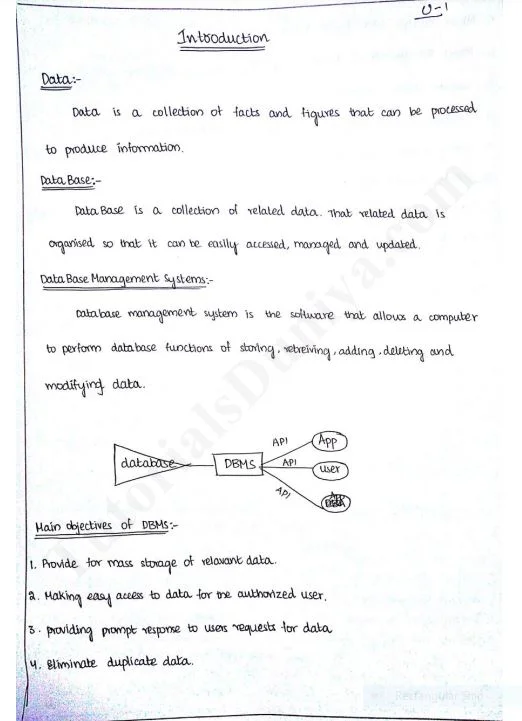| PDF Name | Dbms Notes PDF (Database Management Systems Lecture Notes) |
|---|---|
| No. of Pages | 144 |
| PDF Size | 17.7 MB |
| PDF Category | Notes |
| Last Updated | September 18, 2024 |
| Source / Credits | scribd |
| Comments ✎ | 0 |
| Uploaded By | Stephen |
DBMS Notes PDF Handwritten
Database Management Systems (DBMS) are essential for organizing, storing, and managing data in a structured manner. Whether you’re a computer science student or preparing for exams, having well-organized DBMS notes is crucial. Handwritten notes, in particular, can help reinforce your understanding, as writing things down helps you retain information better. In this article, we’ll cover the key topics you should include in your DBMS handwritten notes and how to convert them into a PDF for easy access and sharing.

Why Choose Handwritten Notes for DBMS?
Handwritten notes have several advantages:
- Boosts Memory: Writing by hand helps you remember important concepts.
- Personalized Learning: You can organize the notes in a way that makes sense to you.
- Quick Revision: Concise, handwritten notes are great for last-minute exam preparation.
- Portable in PDF: Once you convert your notes into PDF format, you can review them anywhere, anytime.
Key Topics for DBMS Handwritten Notes
When creating your handwritten notes for DBMS, make sure to cover the following essential topics:
1. Introduction to DBMS:
- What is a Database?
- Difference between DBMS and RDBMS.
- Types of Databases (Hierarchical, Network, Relational, Object-oriented).
2. Database Models:
- ER (Entity-Relationship) Model: Entities, Attributes, Relationships.
- ER Diagrams: Symbols and notations.
- Normalization: 1NF, 2NF, 3NF, and BCNF.
3. SQL (Structured Query Language):
- SQL Basics: SELECT, INSERT, UPDATE, DELETE.
- SQL Joins: INNER JOIN, LEFT JOIN, RIGHT JOIN, FULL JOIN.
- Aggregate Functions: COUNT, SUM, AVG, MAX, MIN.
- Subqueries and Nested Queries.
4. Keys in DBMS:
- Primary Key.
- Foreign Key.
- Candidate Key.
- Composite Key.
5. Database Design:
- Schema Design and Types (Physical, Logical, View).
- Functional Dependencies.
- Indexing and Hashing.
6. Transaction Management:
- ACID Properties (Atomicity, Consistency, Isolation, Durability).
- Concurrency Control.
- Deadlock Handling.
- Transaction Schedules and Serializability.
7. Normalization and Denormalization:
- Importance of Normalization.
- How to Normalize Database Tables.
- Denormalization: When to use it.
8. Database Security:
- Authentication and Authorization.
- SQL Injection.
- Encryption and Backup Techniques.
How to Structure Your DBMS Handwritten Notes
1. Use Headings and Subheadings:
Organize your notes by topic with clear headings, such as “ER Model” or “Transaction Management.” This makes it easier to find specific information when reviewing.
2. Include Diagrams:
DBMS involves many concepts that are better understood with diagrams. Draw ER diagrams, tables for normalization examples, and flowcharts for transactions.
3. Use Bullet Points:
Bullet points help keep your notes concise. Instead of long paragraphs, break down key points. For example:
- Primary Key: Uniquely identifies a record in a table.
- Foreign Key: Links two tables together.
4. Add Examples and SQL Queries:
Always include examples of SQL queries or database tables. For instance, if you’re explaining joins, write sample queries to show how they work:
sql
SELECT students.name, courses.course_name
FROM students
INNER JOIN courses
ON students.course_id = courses.course_id;5. Use Highlighters and Color Coding:
Highlight important terms like “Normalization,” “ACID properties,” and SQL commands. This helps during quick revisions.
